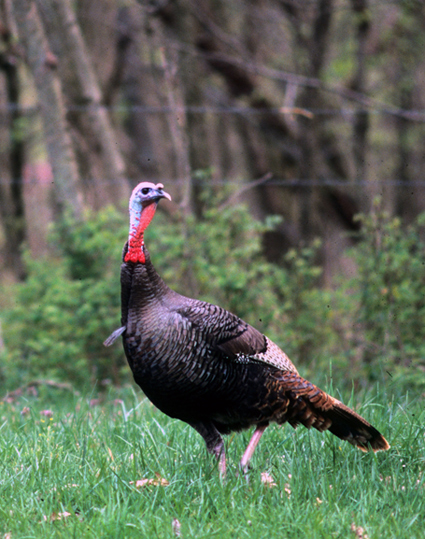By Art Lander Jr
FRANKFORT, Ky. – Kentucky’s spring wild turkey season has been so successful the past 15 years in part because of the timing of opening day.
“I think we’ve accomplished our goal of having a productive season in a relatively short time frame,” said Steven Dobey, wild turkey program coordinator for the Kentucky Department of Fish and Wildlife Resources. “We’ve hit that window between the onset of breeding and nesting.”

Kentucky’s statewide spring turkey season opens every year on the Saturday closest to April 15 and lasts for 23 days. This year, the season dates are April 14 through May 6, 2012.
The turkey hatch peaks in late May or June, weeks after hunting has concluded.
“Our flock is stable, with a population estimate of about 250,000 birds,” said Dobey. “Geographically, Kentucky is in a great location. We have relatively mild winters, a long growing season and a fairly dry early summer, all of which benefit turkeys.”
The harvest of turkeys during the spring season has grown steadily in the past 15 years, from 13,606 in 1996 to 32,191 in 2011.
“Our stocking efforts have paid off and in the early years we had a conservative harvest strategy that’s really paying dividends now,” said Dobey. “Statewide, our turkey population is in excellent shape.”
Kentucky Fish and Wildlife released 6,760 wild turkeys on 430 sites across the state from 1978 through 1997. Restoration was completed in 1997, when Kentucky’s wild turkey population had increased to around 130,000 birds.
Hunters bagged over 30,000 turkeys for two consecutive years for the first time starting in 2010, when there was a record harvest of 36,097 birds.
Dobey said he believes last year’s spring harvest of 32,191 would have been higher, possibly setting a new record, if the weather had cooperated. “About 58 percent of the harvest occurs during the two-day youth-only season and the first week of our statewide season,” said Dobey.
Weather is the one factor that biologists can’t control. “We keep our fingers crossed every year. If it’s sunny on opening weekend, we’ll have a higher harvest,” said Dobey. “Last season we had heavy rains across most of the state, and the opening weekend harvest dropped 27.1 percent from the previous year.”
This season hunters are likely to encounter fewer juvenile gobblers while afield. The weather had an adverse impact on last year’s reproduction. The statewide brood survey for 2011 showed a 42 percent decline in the number of hens observed with at least one poult (young turkey). Statewide, the average number of poults per hen dropped to roughly one and a half.
“Western and central Kentucky appear to have had a little better reproductive success than the rest of the state,” said Dobey. “The birds that nested the earliest were significantly impacted by the heavy rains and flooding.”
Hunters could see fewer older gobblers, too, this coming season. The good news, however, is there will be lots of two-year-old birds which do most of the gobbling.
Kentucky’s turkey flock is arguably the best in the region.
Based on the number of birds taken per square mile, Kentucky has a higher harvest than six of the seven adjoining states — Indiana, Ohio, West Virginia, Virginia, Missouri and Illinois. “We’re on par with Tennessee,” said Dobey, “but our season is half as long as Tennessee’s, and our bag limit is half theirs.”
Dobey said Kentucky has about 90,000 turkey hunters.
Of the successful hunters, about 25 percent take the season limit of two birds in the spring. Most of the birds harvested are adults. “Last season 16.7 percent of the birds taken were juveniles (jakes),” said Dobey. “With the impressive statewide flock in Kentucky hunters are able to be selective, and key on older birds.”
Author Art Lander Jr. has been writing about the outdoors since the 1970s. He is a staff writer for Kentucky Afield Magazine
Media Contact: Art Lander Jr 1-800-858-1549, ext. 4414


Be the first to comment